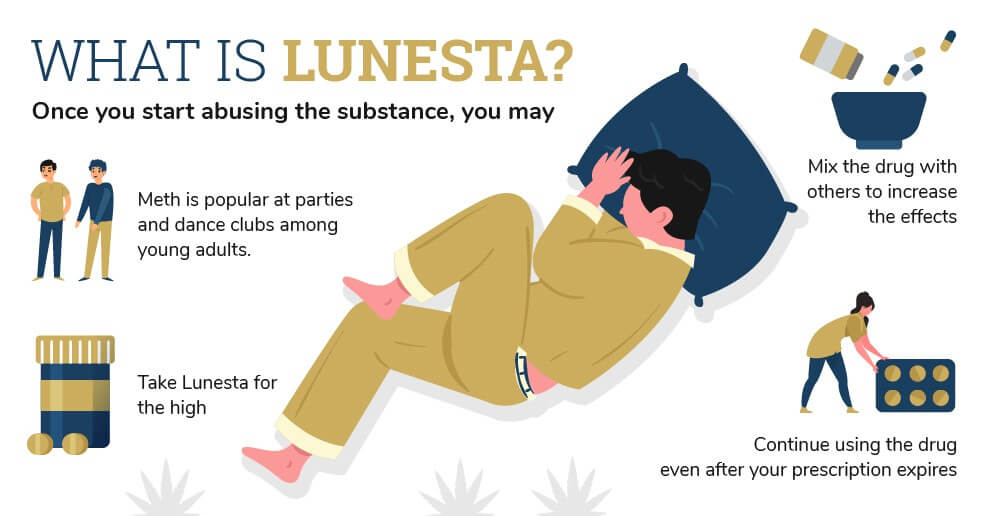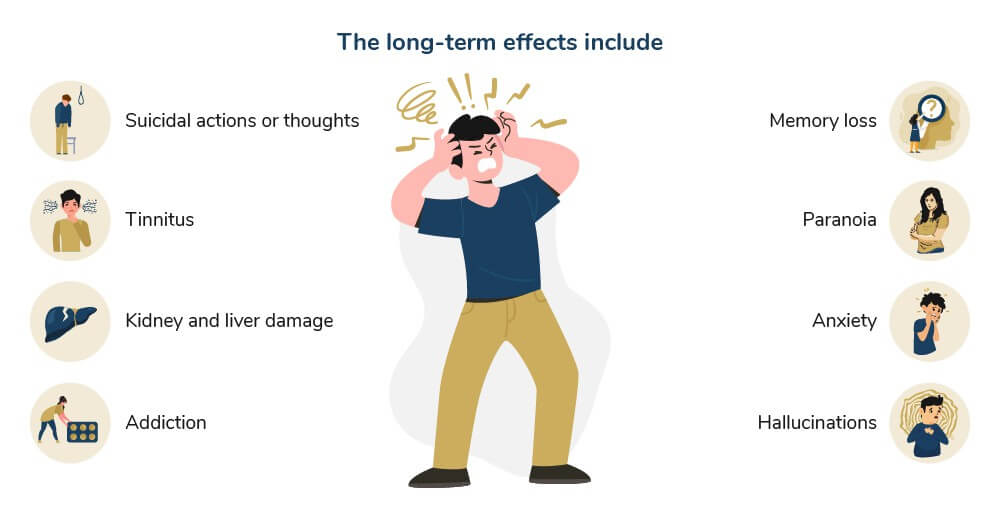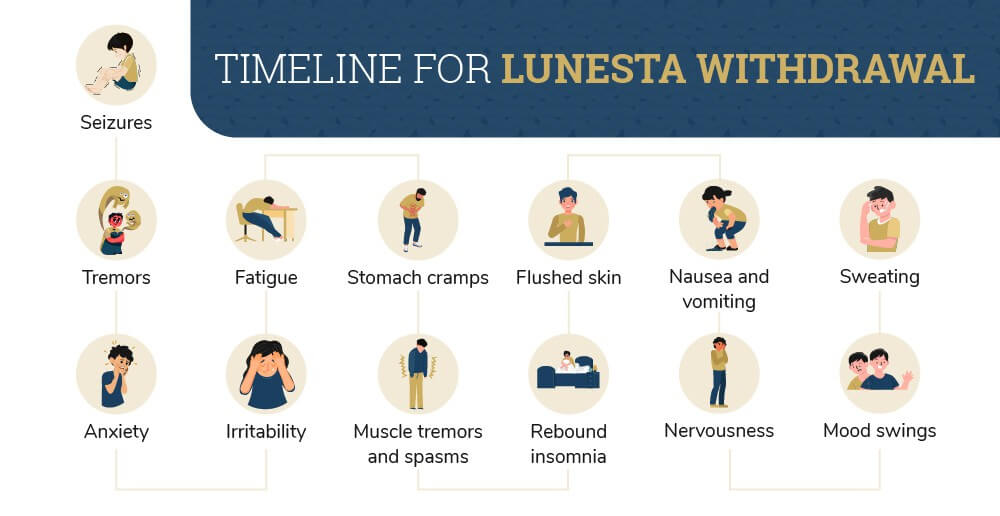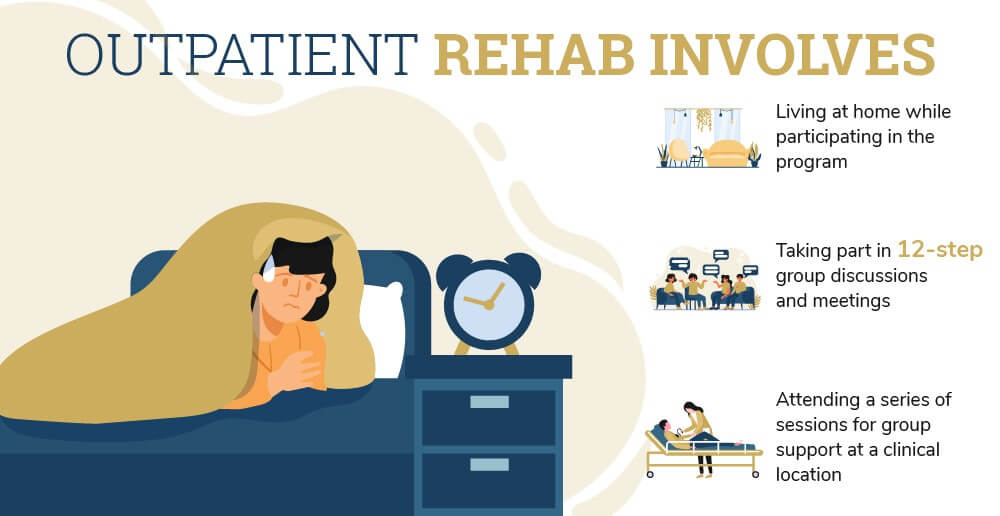As a sedative, Lunesta is classified as a non-benzodiazepine drug. Lunesta is prescribed for insomnia due to the effectiveness. The drug also has a high potential for abuse, addiction and interactions with other medications and substances. Lunesta is only prescribed by physicians to treat insomnia for the short-term. Insomnia is a difficult issue to cope with. Unfortunately, some of the individuals prescribed this drug as a sleep become dependent and Lunesta withdrawal is possible.
Lunesta becomes the only way they can get a night of high-quality sleep. Despite the prescription written for the short-term, the person becomes dependent. If you have become addicted to Lunesta, you will most likely begin using more of the drug to obtain the same effect within a short period of time. An addiction to Lunesta will significantly impact your life. You can become more susceptible to accidents, feel drowsy or sleep too much because of the drug.
If you do not receive assistance from trained therapists and medical professions, quitting Lunesta by yourself is not only extremely difficult but dangerous as well. Understanding the withdrawal timelines and symptoms and why a supervised detox facility can help you stop using this drug safely is critical for your success. Lunesta is the brand name of a drug called eszopiclone and a hypnotic, non-benzodiazepine sedative.

Lunesta is classified in the same class as many sedatives created to induce sleep often referred to as Z-drugs including Sonata and Ambien. The pills have a circular shape with a blue or white coloration. Lunesta is available in one, two and three mg strengths. The drug is supposed to be consumed orally but Lunesta is often snorted to intensify the effects. Due to the significant abuse potential, the drug is for short-term usage only and highly-regulated.
Lunesta is unable to be purchased over-the-counter because it is only available with a prescription. Unfortunately, once a person becomes addicted, they usually find a way to purchase the drug illegally. The street names of Lunesta include sleepeasies, zombies and sleepers. Once you start abusing the substance, you may:
If you use Lunesta for a long time or for recreational purposes, it can become addictive. When taken in large doses, the result is a euphoric effect. If you are also using other drugs, the effect will be intensified. Some people use the drug to help them sleep, others to get high. Approximately nine million people in the United States are using prescription drugs to sleep including Lunesta. Among them, 30 percent have become addicted.
Lunesta is not as addictive as benzodiazepine drugs, but if you do not follow the prescribed dosage or take it for too long, you can become addicted. Lunesta is often used with opioid drugs and alcohol. Not only will this increase your risk of dependence, but it is also dangerous due to the potential for overdose. The bottom line is yes, Lunesta is addictive.
Some people using Lunesta or using too large a dosage have a severe allergic reaction. If this happens, you need to obtain emergency medical assistance. The most common signs of a reaction include:
If you are abusing Lunesta, you may perform actions when not completely awake and not remember them later such as making a phone call, driving or walking. This behavior is extremely dangerous. If you drive or walk when you are not completely awake you are risking severe injury or your life. If you are abusing Lunesta, you are risking significant psychological and physical side effects. The short-term effects include:

The long-term effects include:
When a person becomes addicted to Lunesta, the following symptoms are common.
Lunesta is meant to be used for the short-term only. This means if you use the drug for the long-term, the risk of addiction and physical dependence increases. Once you have become addicted, you need to enter a detox facility to safely stop using Lunesta.
Call us today to connect to an admissions counselor who can help you get started on your journey towards recovery.

Once you become addicted, your withdrawal symptoms can last for a few weeks or several months after you stop using Lunesta. The time you will need for withdrawal depends on specific individual factors. Medical personnel is available in a detox facility to decrease the duration and severity of your withdrawal symptoms. During withdrawal, you can experience distressing and very intense symptoms including:
When you have insomnia, specific neurotransmitters and neurochemicals necessary for the regulation of sleepiness, anxiety and relaxation levels are unable to be produced by your brain. This production is increased by the drug to stop the insomnia cycle. If you use more Lunesta than you should for a long period of time, the chemicals in your brain go haywire. This is the reason intense rebound insomnia is possible after you stop using Lunesta.
You can also experience physical anxiety symptoms including tremors and sweating. If you quit the drug suddenly, all of these symptoms can become intensified. This is one of the reasons remaining sober is difficult. Anyone experiencing these disruptive, intense and painful symptoms has a greater risk of relapsing. Although it is rare, dangerous seizures are possible when you stop taking Lunesta. Detoxing from this drug is extremely uncomfortable and numerous people start using it again.
For these reasons, detoxing in a supervised detox center is critical. Entering medical detox offers you professional assistance 24/7. Medications are administered by the staff to help with uncomfortable withdrawal symptoms so you can achieve sobriety gradually. This decreases your risk of relapse because you are withdrawing in a sober and supportive environment. You do not have to risk the temptation of using the drug because you receive the professional care necessary to comfortably achieve sobriety.
When you stop abusing Lunesta, the emotional symptoms can be painful such as:
The difference between medically supervised Lunesta detox and quitting cold-turkey is tremendous. Quitting cold-turkey means you stop using Lunesta suddenly. This will trigger intense emotional and physical symptoms within 12 hours after you consumed your last dosage. In some instances, the symptoms are dangerous. When your detox is supervised by trained medical staff, your risks are decreased due to qualified therapists and doctors.
Your dosage of Lunesta will be decreased gradually or you will be given a non-benzodiazepine replacement for the drug. When you taper off Lunests, the amount of the drug remaining in your system decreases gradually. This is a lot gentler for your body and stops you from experiencing the potentially dangerous, intense and painful symptoms of withdrawal. By choosing to detox in a controlled atmosphere, you have the benefit of a safe environment and medical support. Your risk of relapsing due to a painful withdrawal is substantially decreased.
Receiving either a replacement sleep aid or gradually decreasing doses of Lunesta while in detox is safe. Due to the medical supervision provided, you can also take medication for both anxiety and nausea throughout the withdrawal process.
Quitting the drug cold-turkey is not safe. You need to taper off with a replacement drug schedule. If you do not do this, you can experience rebound insomnia and dangerous seizures. Consuming anything that can make your insomnia or anxiety worse such as caffeine is not safe.
First, you will receive a physician assessment for the severity and duration of your Lunesta abuse. In order to be placed on a schedule to taper off effectively and safely, the physician must know the amount of Lunesta you have taken and for how long. Any underlying conditions and polydrug use will also be assessed at this time. This step is important because these factors impact the symptoms and timeline of your withdrawal.
Other sleep aids are less likely to result in intense withdrawal symptoms. Lunesta was created to help you fall asleep and remain asleep. This means Lunesta will remain in your system for a longer period of time. This affects the duration and severity of your withdrawal symptoms. While the other sleep aids will help you fall asleep, they will not help you stay asleep.
There are several factors influencing your withdrawal and the severity including:
If you try to quit without obtaining support and help from trained medical professionals, you are taking an unnecessary risk. Attempting to detox while you are at home places you in the position of relapsing while risking both your safety and health. To be able to detox safely, you need to be in a safe environment where physicians are available to monitor you for side effects. When you get the help you need, you can live a fulfilling and sober life after Lunesta.
Depending on the length and severity of your addiction, you may decide to continue your treatment after detox. You can accomplish this with a rehab program. The physical part of drug abuse is addressed while you are in a detox facility. Detox by itself is not a cure for drug abuse or addiction. This is because in order to determine what was responsible for your addictive behavior, you need to understand and deal with your behavioral issues.
This is the reason rehab facilities were established. The main purpose of rehab for Lunesta is to:

There are different types of programs and rehab centers for Lunesta addiction and abuse. According to recent research, your best chance of remaining sober is a program lasting a minimum of 90 days. Despite the convenience of 30-day programs, it is not a suitable option for everyone. When you look for treatment for your addiction, you have two basic options, outpatient or inpatient drug rehab. The two types of programs are different for many reasons. Outpatient rehab involves:
Inpatient rehab involves:
Getting sober is hard, but you don’t have to do it alone. Contact Asana Recovery today for a confidential assessment.
At Asana Recovery, we understand the difficulties of Lunesta addiction and withdrawal. Our experienced team is committed to providing compassionate, personalized care through a variety of programs designed to help you recover safely and effectively. No matter where you are on your journey, we have the right program for you:
Contact us today to start your recovery from Lunesta withdrawal. We’re here to guide you every step of the way.

© Copyright 2024 Asana Recovery™ | All Rights Reserved | Privacy Policy
Asana Recovery
We firmly believe that the internet should be available and accessible to anyone, and are committed to providing a website that is accessible to the widest possible audience, regardless of circumstance and ability.
To fulfill this, we aim to adhere as strictly as possible to the World Wide Web Consortium’s (W3C) Web Content Accessibility Guidelines 2.1 (WCAG 2.1) at the AA level. These guidelines explain how to make web content accessible to people with a wide array of disabilities. Complying with those guidelines helps us ensure that the website is accessible to all people: blind people, people with motor impairments, visual impairment, cognitive disabilities, and more.
This website utilizes various technologies that are meant to make it as accessible as possible at all times. We utilize an accessibility interface that allows persons with specific disabilities to adjust the website’s UI (user interface) and design it to their personal needs.
Additionally, the website utilizes an AI-based application that runs in the background and optimizes its accessibility level constantly. This application remediates the website’s HTML, adapts Its functionality and behavior for screen-readers used by the blind users, and for keyboard functions used by individuals with motor impairments.
If you’ve found a malfunction or have ideas for improvement, we’ll be happy to hear from you. You can reach out to the website’s operators by using the following email
Our website implements the ARIA attributes (Accessible Rich Internet Applications) technique, alongside various different behavioral changes, to ensure blind users visiting with screen-readers are able to read, comprehend, and enjoy the website’s functions. As soon as a user with a screen-reader enters your site, they immediately receive a prompt to enter the Screen-Reader Profile so they can browse and operate your site effectively. Here’s how our website covers some of the most important screen-reader requirements, alongside console screenshots of code examples:
Screen-reader optimization: we run a background process that learns the website’s components from top to bottom, to ensure ongoing compliance even when updating the website. In this process, we provide screen-readers with meaningful data using the ARIA set of attributes. For example, we provide accurate form labels; descriptions for actionable icons (social media icons, search icons, cart icons, etc.); validation guidance for form inputs; element roles such as buttons, menus, modal dialogues (popups), and others. Additionally, the background process scans all the website’s images and provides an accurate and meaningful image-object-recognition-based description as an ALT (alternate text) tag for images that are not described. It will also extract texts that are embedded within the image, using an OCR (optical character recognition) technology. To turn on screen-reader adjustments at any time, users need only to press the Alt+1 keyboard combination. Screen-reader users also get automatic announcements to turn the Screen-reader mode on as soon as they enter the website.
These adjustments are compatible with all popular screen readers, including JAWS and NVDA.
Keyboard navigation optimization: The background process also adjusts the website’s HTML, and adds various behaviors using JavaScript code to make the website operable by the keyboard. This includes the ability to navigate the website using the Tab and Shift+Tab keys, operate dropdowns with the arrow keys, close them with Esc, trigger buttons and links using the Enter key, navigate between radio and checkbox elements using the arrow keys, and fill them in with the Spacebar or Enter key.Additionally, keyboard users will find quick-navigation and content-skip menus, available at any time by clicking Alt+1, or as the first elements of the site while navigating with the keyboard. The background process also handles triggered popups by moving the keyboard focus towards them as soon as they appear, and not allow the focus drift outside it.
Users can also use shortcuts such as “M” (menus), “H” (headings), “F” (forms), “B” (buttons), and “G” (graphics) to jump to specific elements.
We aim to support the widest array of browsers and assistive technologies as possible, so our users can choose the best fitting tools for them, with as few limitations as possible. Therefore, we have worked very hard to be able to support all major systems that comprise over 95% of the user market share including Google Chrome, Mozilla Firefox, Apple Safari, Opera and Microsoft Edge, JAWS and NVDA (screen readers).
Despite our very best efforts to allow anybody to adjust the website to their needs. There may still be pages or sections that are not fully accessible, are in the process of becoming accessible, or are lacking an adequate technological solution to make them accessible. Still, we are continually improving our accessibility, adding, updating and improving its options and features, and developing and adopting new technologies. All this is meant to reach the optimal level of accessibility, following technological advancements. For any assistance, please reach out to